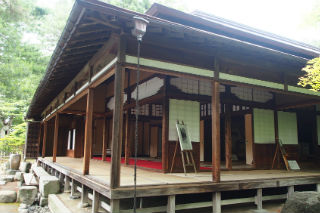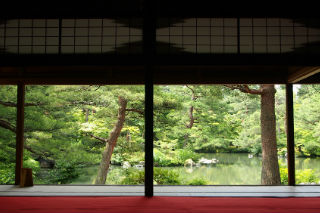Keeping alive the ambience of Edo culture to this day
”Shimizu-en,” a Japanese garden located in Shibata-City, Niigata Prefecture is a well-known feudal lord’s garden in the Echigo region. The promenade garden was built by Shibata clan during Edo era. In the center of the garden is a large pond shaped like the Chinese character ”water” in ”sosho” style with five tea houses interspersed around the pond. ”Satsuma Sugi” (a type of Japanese cedar) surrounding the garden and ”Aomori Tsuga” (a type of Japanese hemlock) are rare in this region. You can deduce how the distribution system of the period worked and assume how they strove to raise the social status of the garden by planting rare trees. The beautifully borrowed scenes from ”The Eight Views of Omi” : ”Wild Geese Returning Home at Katata,” ”Evening Bell at Miidera,” ”Evening Glow at Seta,” ”Autumn Moon at Ishiyama,” ”Clear Breeze at Awazu,” ”Returning Sails at Yabase,” ”Evening Rain at Karasaki,” ”Evening Snow at Hira,” was designated National Place of Scenic Beauty in 2003.

The simple style of “Shoin”
The reception room on the right side of the central gate is a 250㎡ single-story house with hipped roof called ”Shimizutani Goten.” It was built as a place for the feudal lord to appreciate the garden. One will observe from the traces of ”Noh” stage that ”Noh” and other performances were held here and that the house was a place to relax and recuperate for the feudal lords. Two adjacent ”Kyoma” rooms open up onto the pond, the wooden floor of the 50㎡ room connected to hook-shaped corridor has a floor applied with ”Shunkei” lacquer. The very simple, undecorated style eliminating extravagance show their political consideration towards Edo shogunate.

The five tea houses blending into the elegant scenery
In the castle town of Shibata, tea ceremony was very popular. Successive lords of ”Shibata clan” put great importance to tea ceremony and built five tea houses in different styles, ”Toan,” ”Yukatei,” ”Suitoan,” ”Dojinsai,” ”Shogetsutei,” around the pond. In late 1940s to the ‘50s, tea master Taiami Tanaka restored the deteriorated garden and the tea houses based on the information from ”Shimizutani-goten picture scroll and records.” The interior of the tea houses is not normally open to the public, but are sometimes used as tea ceremony venue. The tea houses blending into the scenery with the pond hold an essential charm unequalled anywhere else northeast of the Echigo region. It plays an important role in passing on Edo culture to the present.




